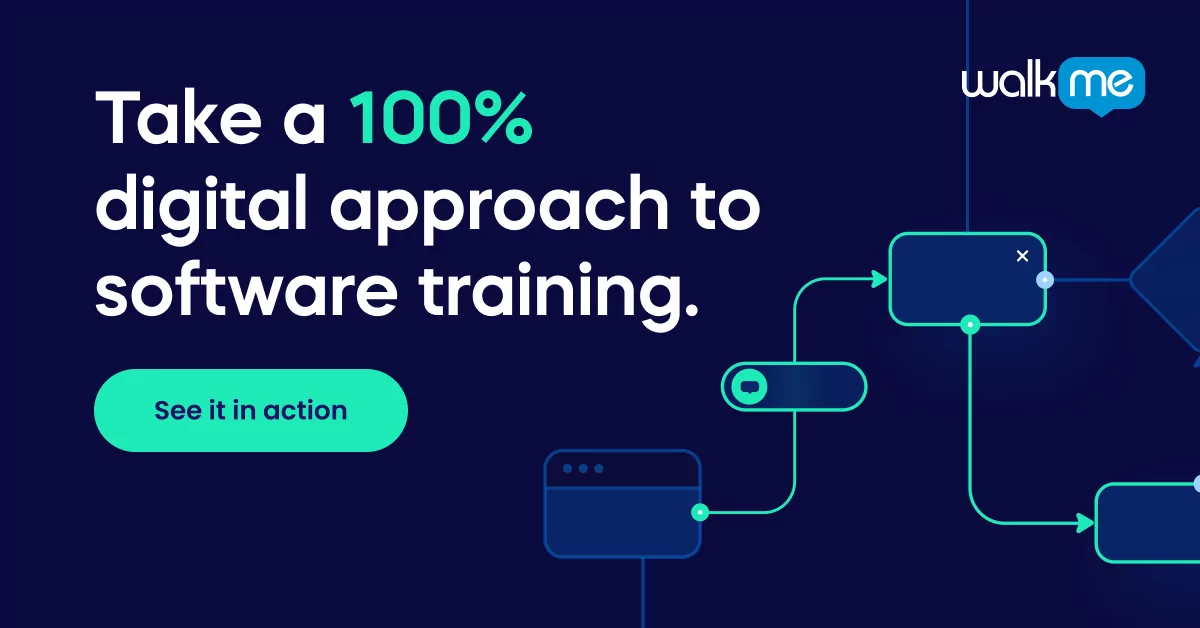Many leaders in 2023 only chase short-term goals to acquire talent for their organization.
The talent acquisition process requires a broader perspective to see the wider factors impacting the talent market and how they must battle increasing talent-market complexity to compete for the best staff within a longer-term plan.
This background is why LinkedIn reports that 87% of recruiting professionals say talent acquisition has become a more strategic element to their approach in the last year.
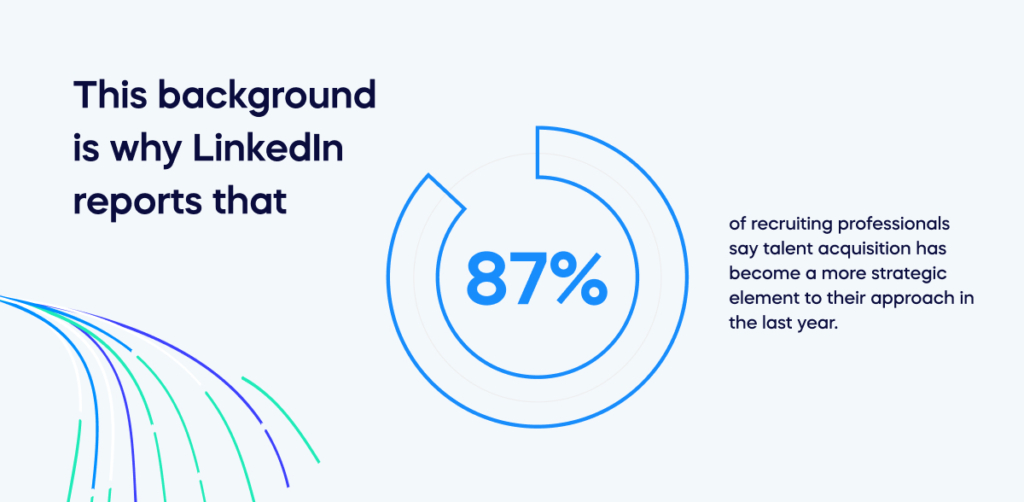
What is talent acquisition strategy ?
An effective talent acquisition strategy helps you see the bigger picture and present your organization in the best light to attract the highest-performing staff to bring your company a fresh innovation perspective.
To help you structure your talent acquisition strategy to ensure success, this article will cover the following topics:
- What is the purpose of a talent acquisition strategy?
- What are the stages of talent acquisition strategy?
- How do you build a talent acquisition strategy?
What is the purpose of a talent acquisition strategy?
WEBMASTER: Please embed this link.
Talent Management Tutorial – What is a talent management strategy?
The purpose of a talent acquisition strategy is to define the plan and set the milestones for how you will acquire the talent you need in your organization. It focuses on a broader perspective and long-term goals that align with your company objectives to achieve your talent acquisition needs.
Talent acquisition vs. recruitment
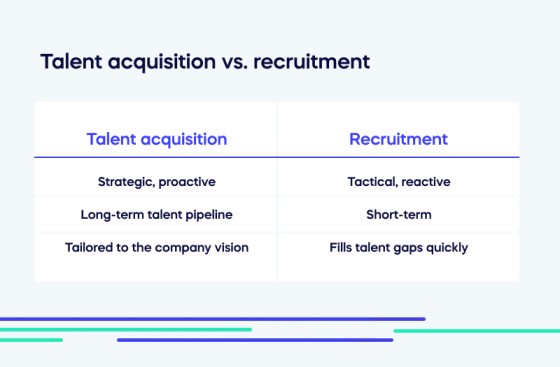
It is easy to get talent acquisition and recruitment mixed up, so let’s look at them side by side.
Talent acquisition
Strategic, proactive
Long-term talent pipeline
Tailored to the company vision
Recruitment
Tactical, reactive
Short-term
Fills talent gaps quickly
Recruitment is a short-term strategy that aims to fill a specific role with a qualified candidate. On the other hand, talent acquisition is a long-term HR strategy that focuses on attracting highly qualified candidates regardless of any vacancies.
Utilize both talent acquisition strategies and short-term recruitment cycles to ensure a successful hiring process for your business. Combining these approaches will help you to attract and retain high-quality candidates.
What are the 6 stages of talent acquisition strategy?
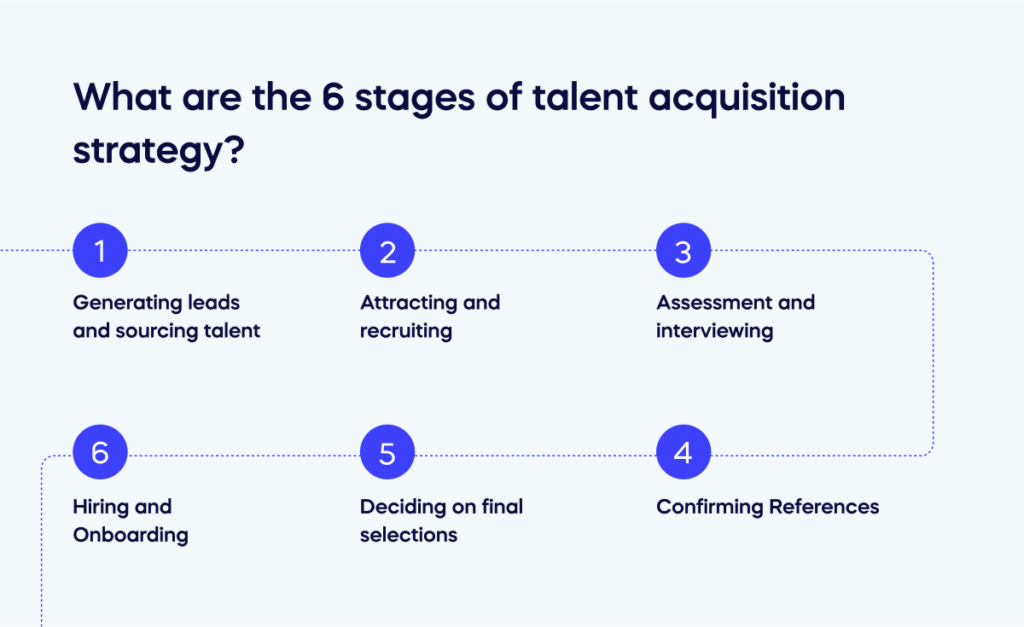
A successful talent acquisition strategy has six stages. The first is beginning with generating leads and sourcing talent.
Follow these steps to acquire the needed talent and maintain high employee retention efficiently.
1. Generating leads and sourcing talent
To attract potential candidates for a job, begin with an appealing job description. Next, identify social networks, industry events, online forums, and communities where professionals within your industry often gather.
Then, you can attend such events and engage with experts to establish relationships and publicize your talent needs. Doing so will help you create a vast pool of potential candidates and build a solid lineup of potential hires.
2. Attracting and recruiting
To attract and retain top talent, building a solid company brand, promoting a unique company culture, and designing a competitive compensation package are essential.
Additionally, it is crucial to manage candidate relationships by creating a positive employee experience for candidates, pursuing potential candidates, and maintaining communication with those who may not be a good match now but could be in the future.
3. Assessment and interviewing
First, list the 3-5 crucial tasks required for the position and determine the key performance indicators to measure success.
Next, create interview questions focusing on the candidate’s behaviors, such as problem-solving abilities, resourcefulness, and quick thinking.
Additionally, you can evaluate candidates with other methods, including skills tests, personality or cognitive assessments, or a practical demonstration.
4. Confirming References
Checking a candidate’s references before making a final decision is recommended to help confirm your initial impression of the candidate and uncover potential concerns.
If the reference verifies that the candidate possesses the necessary qualifications and character, you can confidently proceed with making an offer.
5. Deciding on final selections
To streamline the final selection process for your top candidates, utilize people tracking and evaluative software or an internal HR grading system.
HR analytics data should be accessible to your talent team and other stakeholders involved in decision-making.
To accommodate busy C-suite members and other employees, ensure the selection process is transparent and straightforward.
6. Hiring and Onboarding
While the talent acquisition team may not be directly responsible for hiring and onboarding, it is a crucial step in bringing on top talent. It’s important to note that a well-planned onboarding process can significantly impact the relationship with a new employee.
Therefore, it’s essential to efficiently prepare and streamline this process before the new hire’s start date.
How do you build a talent acquisition strategy in 8 steps?
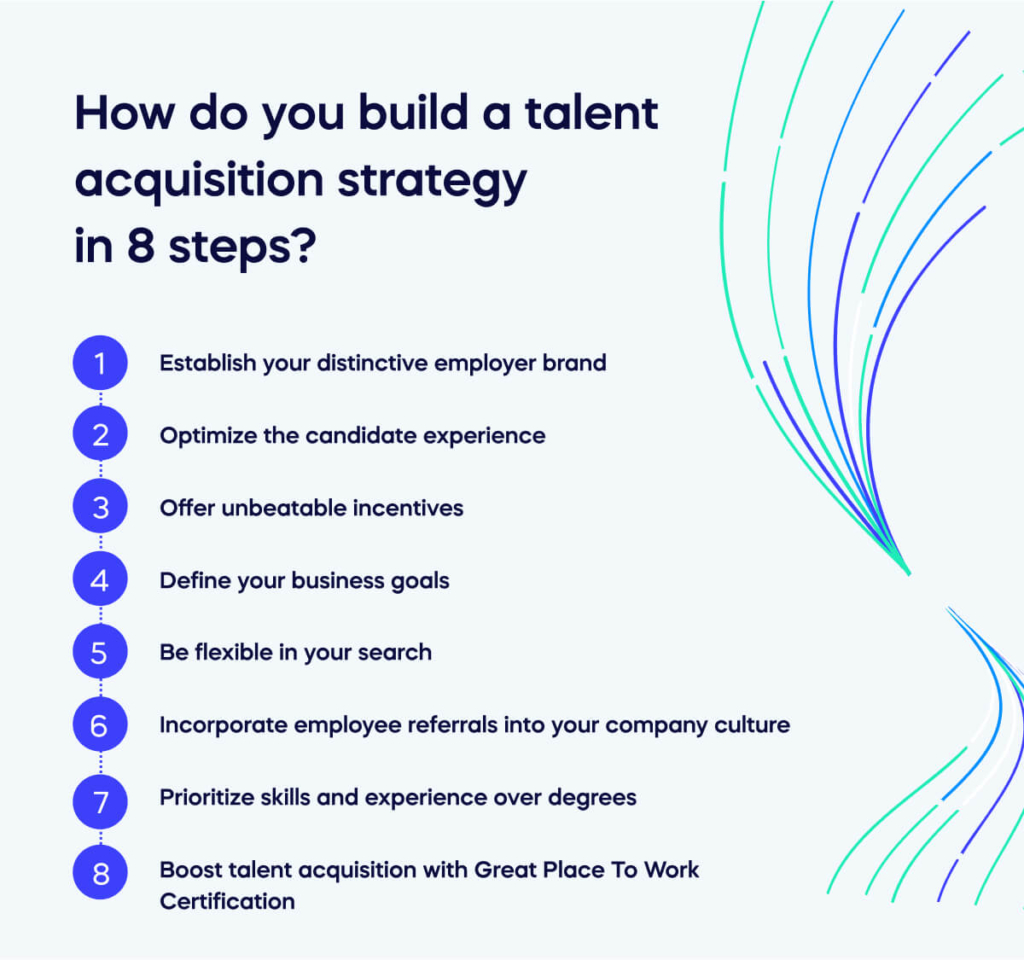
As a company’s demands change, it’s essential to review and refine talent acquisition routinely. Address gaps within your recruiting efforts and incorporate them within your talent acquisition strategy.
Consider these eight tactics to ensure every step of your talent acquisition efforts aligns with your priorities:
1. Establish your distinctive employer brand
Can you provide information on the strength of your employer brand? In what ways does your company differentiate itself from competitors? And how well does your employer brand align with your mission, values, and goals?
When job applicants are interested in working for your organization, they will check out your careers page, social media accounts, and websites similar to Glassdoor.
Example
The way you write your job description reflects your employer’s brand. YNAB, for instance, creates job descriptions that are three to four times lengthier than usual and elaborate on the work the candidate will do on their typical day and what success would mean.
Like a candidate’s resume, the employer brand should tell a story, distinguish the company in the market and persuade potential employees to choose that company.
2. Optimize the candidate experience
To improve the candidate experience, conduct a comprehensive audit of your application process. Evaluate every interaction from the candidate’s perspective, including emails, automated messages, job description language, and more.
Remember to communicate important information about your company and the role to candidates before engaging with them directly.
Pay close attention to the language used in every email, job posting, and response to ensure you send a positive message about your employee experience strategies.
Example
Construction company Hilti mandates a day-long employee training session for all recruitment team members.
The training covers various topics, including effective interview techniques, evaluating candidates based on the company’s core values, fair hiring practices, and the complete onboarding process.
This requirement ensures that Hilti maintains uniform interviewing standards and delivers a consistently positive experience for each candidate.
3. Offer unbeatable incentives
Rather than simply stating that the workplace is great, consider highlighting your company culture by sharing information about the available benefits or testimonials from current team members.
You could also apply for recognition awards to showcase your status as an exceptional employer.
Example
Consider blogging about your company culture.
You can feature a “day in the life” or interview current team members about why they chose to work for your company. This strategy effectively promotes open roles, shares content, and provides information about your company’s mission, culture, and benefits.
, it is essential to prioritize the employee experience with an authentic desire to create a positive environment for staff to attract and keep the most suitable candidates.
4. Define your business goals
t is essential to identify the required knowledge and skills, consult with stakeholders and hiring managers to understand the team’s needs, and consider unconventional approaches to find the right talent.
You can better understand the relationship between talent acquisition and organizational outcomes using an employee survey tool that provides detailed data and analysis.
Analyze employee experience based on demographics, departments, and management levels. Develop diverse hiring key performance indicators (KPIs) and hold every leader responsible for meeting them.
Receive suggestions on which areas to prioritize and make improvements.
Example
Are you considering expanding to Latin America? If yes, it might benefit your HR department to target candidates with experience in the international or regional market.
Alternatively, if you plan on developing a new product, your HR efforts should concentrate on hiring skilled software developers and coders.
It’s essential to consider the talent you’ll need to achieve your company’s long-term goals, even if you haven’t finalized the details of some roles yet. Remember that hiring suitable candidates will benefit your company in the long run.
5. Be flexible in your search
To ensure you find the best candidates, explore all options for hiring. Utilize alternative sources such as specialized online forums or advocacy groups. Approach individuals who may not be actively job-seeking but are open to new opportunities.
Consider recruiting veterans and incorporating military job boards into your recruiting strategy to discover untapped talent.
Forming good relationships with influential people in the industry and partnering with local organizations and colleges/trade schools is essential.
Investing in the communities where your business is based can help you get to know potential candidates on a deeper level than just looking at their resumes.
Recruiting candidates directly from universities or trade schools with diverse populations offers young individuals from underrepresented communities a chance to access previously unavailable roles.
Example
Bank of America works with 30 community colleges in 10 states to find entry-level employees. They also offer a program for hiring and developing people from low- and moderate-income areas, which includes career training and entry-level jobs.
6. Incorporate employee referrals into your company culture
Encouraging employees to refer potential candidates and promoting your hiring goals throughout the company can help expand your pool of candidates and attract candidates of higher quality as it becomes part of your company culture.
When employees refer someone they know, they can provide valuable insight into their skills, work ethic, and values, making the referred candidate more likely to be a strong match for the position.
The advantages are that a well-designed employee referral program can encourage employees to participate in the hiring process, leading to benefits such as saving time, reducing hiring costs, and improving engagement among current employees.
Example
There are four steps to a successful employee referrals campaign:
- Decide when to ask for referrals.
- Inform employees of the referrals campaign.
- Reward and motivate employees.
- Track employee referrals.
These steps ensure a structured, successful employee referrals campaign that becomes part of your company culture.
7. Prioritize skills and experience over degrees
Employers are now emphasizing skills-based recruitment over academic degrees to gauge a candidate’s abilities.
Employers can improve job fit and performance by prioritizing skills and experience over college degrees, as the latter is not always a reliable indicator of success in a role.
Example
Accenture and Bitwise Industries are both promoting diverse hiring and building their talent framework by eliminating unnecessary degree requirements for specific job postings.
Doing so allows them to open up opportunities for talented individuals who traditional hiring practices in the tech industry may have overlooked.
8. Boost talent acquisition with Great Place To Work Certification
Certification can significantly benefit a company’s recruitment and talent strategy by establishing it as a business that prioritizes a positive work environment, and employees endorse it as an excellent workplace.
Obtaining the Great Place To Work Certification can boost your recruitment and talent strategy by generating increased attention for your company.
This certification validates your organization’s engaged workplace culture and can lead to more job applicants and increased visibility for your business.
Example
Some of the top tech companies that hold Great Place To Work Certification are:
- Cisco.
- Salesforce.
- Millicom.
Before building your talent acquisition strategy, it is essential to analyze your current talent management methods. Identify gaps or deficiencies, and determine how this talent acquisition strategy can help address those issues.
Focus on meaningful incentives within your talent acquisition strategy
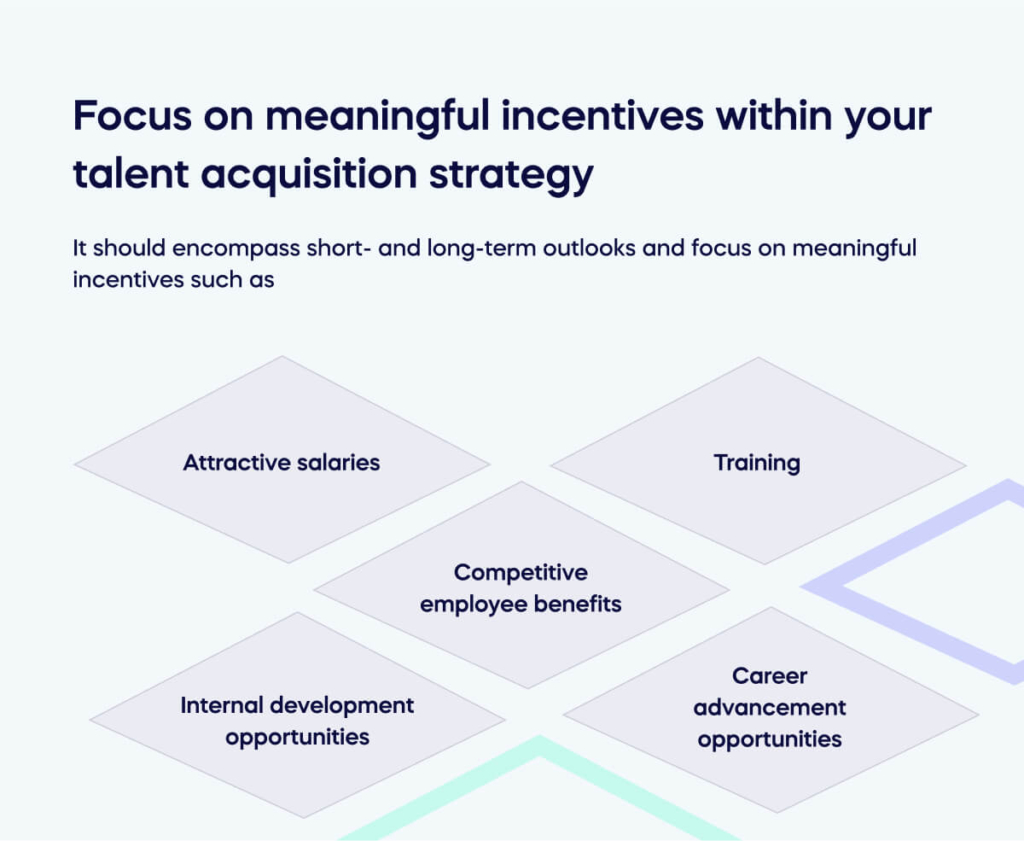
An effective talent acquisition strategy is paramount in placing the right fit for each position within an organization.
It should encompass short- and long-term outlooks and focus on meaningful incentives such as attractive salaries, competitive employee benefits, training, internal development opportunities, and career advancement opportunities.
Focus on meaningful incentives within your talent acquisition strategy to improve your hiring efforts.
It will increase employee satisfaction among current staff and allow future candidates to see an attractive opportunity with your company.
